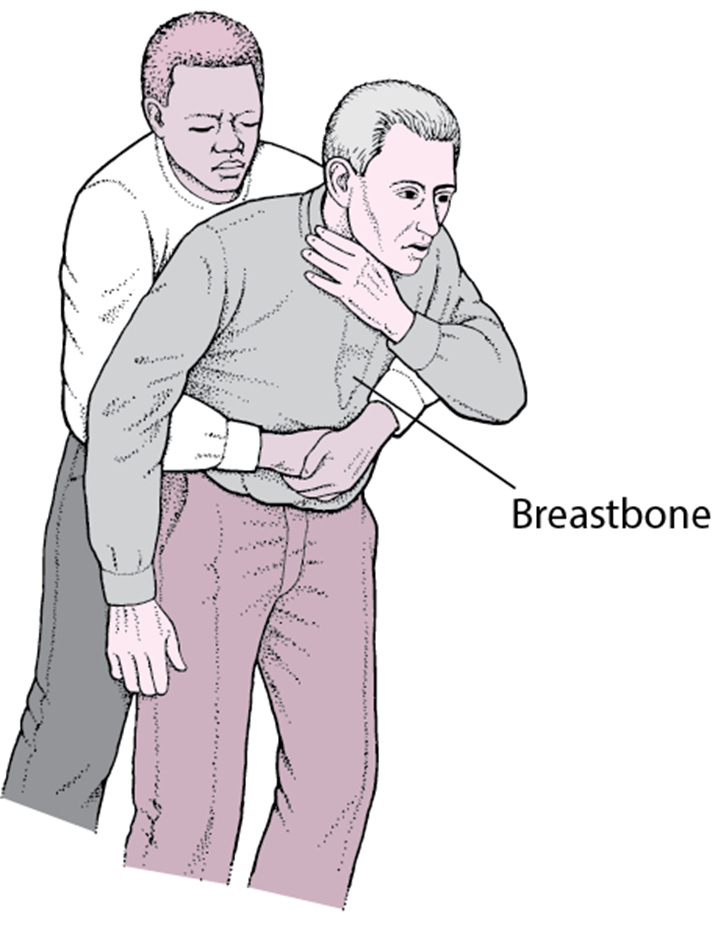A nurse is dining at a restaurant when a woman begins to scream that her partner is choking. Which of the following actions should the nurse take?
Instruct the woman to call 911.
Use the abdominal-thrust maneuver.
Ask the partner if he can speak.
Perform chest compressions.
The Correct Answer is B
A. Instruct the woman to call 911: This is a correct action, but it should be the second step after the nurse initiates first aid measures. Directing someone to call for emergency assistance is crucial, but immediate intervention to relieve the choking takes precedence.
B. The Heimlich maneuver involves abdominal thrusts and is the recommended technique for relieving choking in a conscious person. It is essential to act quickly and decisively to clear the airway.
C. Ask the partner if he can speak: If the person is unable to speak, cough, or breathe, it may indicate complete airway obstruction. The nurse should not delay intervention by asking if the person can speak but should immediately proceed with measures to relieve the choking.
D. Perform chest compressions: Chest compressions are not indicated for a conscious choking victim. Chest compressions are performed in the context of cardiopulmonary resuscitation (CPR) for an unconscious person with no pulse.

Nursing Test Bank
Naxlex Comprehensive Predictor Exams
Related Questions
Correct Answer is D
Explanation
A. Aortic regurgitation: Aortic regurgitation typically presents with a diastolic murmur, not a systolic click.
B. Mitral stenosis: Mitral stenosis presents with a diastolic murmur, often associated with an opening snap, rather than a systolic click.
C. Aortic stenosis: Aortic stenosis typically presents with a systolic ejection murmur, but not a systolic click.
D. Mitral valve prolapse: This is the correct answer. Mitral valve prolapse (MVP) is characterized by the displacement of the mitral valve leaflets into the left atrium during systole, often producing a systolic click. Symptoms associated with MVP can include atypical chest pain, palpitations, and exercise intolerance.
Correct Answer is C
Explanation
A. Impaired tissue perfusion: While impaired tissue perfusion is a concern in clients with varicose veins, the presence of ulcerations indicates that skin integrity is already compromised. Addressing impaired skin integrity is a more immediate concern.
B. Alteration in activity tolerance: Alteration in activity tolerance may be a consequence of impaired tissue perfusion and impaired skin integrity, but the priority is to address the current skin breakdown and prevent further complications.
C. Impaired skin integrity: This is the correct answer. The presence of varicose veins, ulcerations, and lower extremity edema indicates compromised skin integrity. The nurse should prioritize interventions to promote wound healing, prevent infection, and address the underlying causes contributing to impaired skin integrity.
D. Alteration in body image: While body image concerns may arise in clients with varicose veins, the immediate priority is addressing the physical complications such as impaired skin integrity to prevent further deterioration.
Whether you are a student looking to ace your exams or a practicing nurse seeking to enhance your expertise , our nursing education contents will empower you with the confidence and competence to make a difference in the lives of patients and become a respected leader in the healthcare field.
Visit Naxlex, invest in your future and unlock endless possibilities with our unparalleled nursing education contents today
Report Wrong Answer on the Current Question
Do you disagree with the answer? If yes, what is your expected answer? Explain.
Kindly be descriptive with the issue you are facing.
